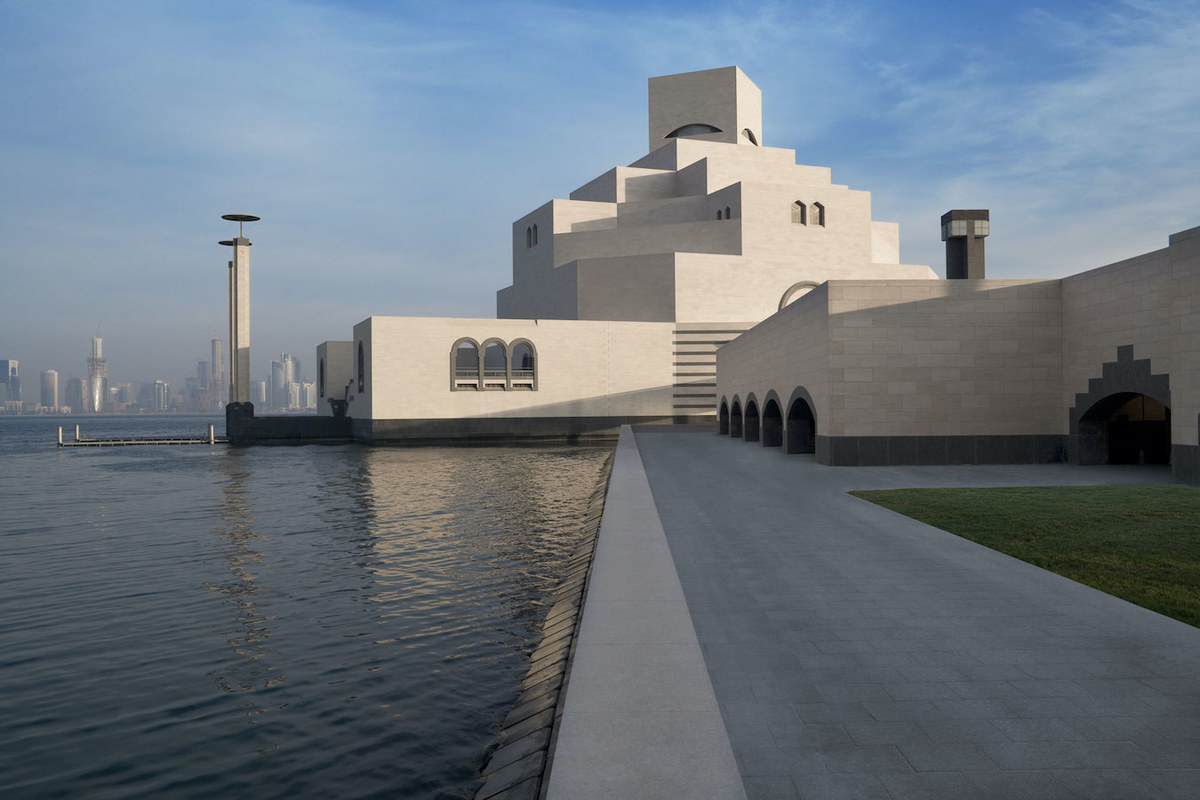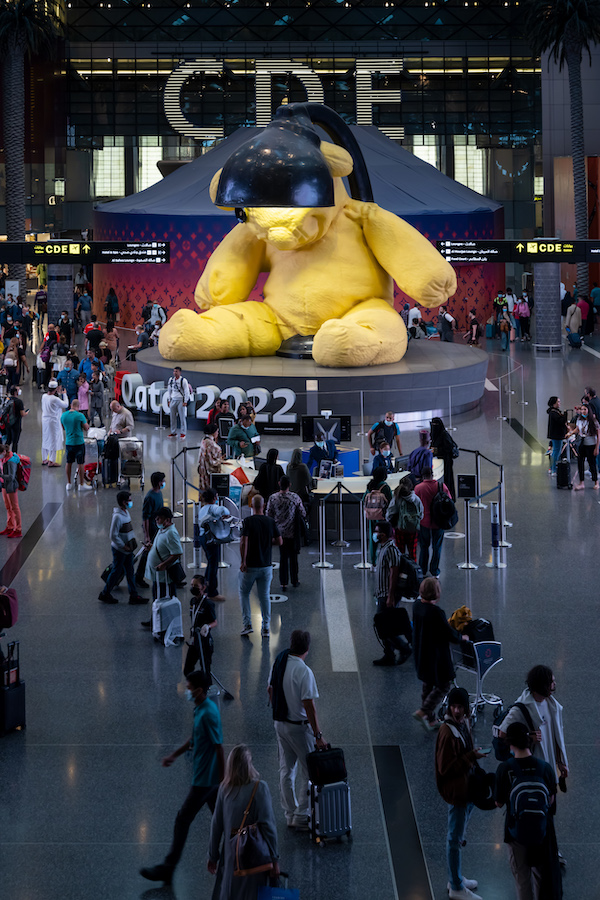DUBAI: After 12 years of preparation to host prestigious FIFA World Cup last year — 12 years that transformed the tiny-gas rich Gulf nation of Qatar — the country is focusing on maintaining its momentum and boosting its tourism and cultural industries.
“The World Cup, to us, was a bonus on top of what we were already doing in the cultural realm,” Sheikha Reem Al-Thani, acting deputy CEO of exhibitions and marketing for Qatar Museums, tells Arab News.
Much of Qatar’s tourism and cultural boom, says Al-Thani, is part of the Qatar National Vision 2030 strategy, which was formalized in July 2008, the same year the Museum of Islamic Art, designed by the renowned Chinese-American architect I.M. Pei, opened in Doha.

Jeff Koons' 'Dugong' in Doha's Al-Masrah Park. (Getty Images)
The World Cup crowds may have left, but a multitude of projects are ongoing, signaling further growth on the horizon. Throughout Doha and in nearby desert landscapes sit dozens of specially commissioned public art installations, 30 percent of which were commissioned in the year leading up to the World Cup. Works by Qatari artists including Shouq Al-Mana, Ghada Al-Kater, Mubarak Al-Malik and Salman Al-Malek sit alongside creations of acclaimed international names such as Jeff Koons, whose “Dugong” — a massive site-specific polychromed mirror-polished stainless-steel sculpture of the marine mammal that symbolizes Qatar’s natural heritage — is stationed near the Corniche. Richard Serra’s “East West/West East” stands in the Qatari desert, as does KAWS’ “The Promise,” depicting a parent and a child contemplating a globe — stressing the need to protect the environment.
“The public art emphasizes our identity while also giving context to everything that is taking place in Qatar,” says Al-Thani. “For example, before Richard Serra’s artwork, people didn’t have much of a reason to go to that area in the desert. Now they go and are encouraged to explore the local landscape.”
According to the Qatar News Agency, the overall attendance at all the World Cup matches combined was 3.4 million. And visitors are still flocking to Qatar. In January 2023, the country registered 3,559,063 people arriving on flights, according to air transport statistics released by Qatar’s Civil Aviation Authority, which marked a 64.4 percent increase from the same period in 2022.

Qatar's Museum of Islamic Art. (Supplied)
The country has set several ambitious targets. By 2030, it aims to attract six million visitors a year and increase the contribution of the tourism sector to its GDP from 7 percent to 12 percent. To that end, the country is investing billions into culture, art, technology and tourism. In February this year, Doha was recognized as the Arab Tourism Capital 2023 by the Arab Tourism Organization.
Qatar Creates, a government-backed, year-round cultural movement conceptualized at the opening of the National Museum of Qatar in 2019 has evolved into an extravaganza combining museum exhibitions, film, fashion, hospitality, cultural heritage, performing arts and private-sector initiatives.
Earlier this month, Qatar Creates Week presented a host of exhibition openings and events, including the Tasweer Photo Festival Qatar — the second biennial program of exhibitions, awards, commissions and collaborations that aims “to diversify practices and dialogues of photographers from Qatar and the Western Asia and North African regions,” “Beirut and the Golden Sixties,” a show at the Mathaf Arab Museum of Modern Art, and Icelandic-Danish artist Olafur Eliasson’s “The Curious Desert” at the NMOQ, bringing together a dozen new site-specific installations located in the desert near the Al-Thakhira Mangrove in Northern Qatar as well as an extensive gallery presentation.

Inside the National Museum of Qatar. (Danica O Kus)
Other highlights include the Doha Film Institute’s Qumra, an initiative offering mentorship and other opportunities for filmmakers in Qatar and around the world.
Elsewhere, “Lusail Museum: Tales of a Connected World” at Qatar Museums’ Gallery Al-Riwaq in Doha introduced the new museum, designed by Herzog & de Meuron, currently under development in Lusail, Qatar’s second-largest city. It will be dedicated to Orientalist art, archaeological artifacts, and media from prehistoric times to the 21st century.
The Lusail Museum is one of three new museums that Qatari global art patron Sheikha Al-Mayassa Al-Thani announced in March to expand the country’s cultural offerings. The others are the Qatar Auto Museum and the Art Mill on Doha’s waterfront promenade, which is due to open in 2030 and that will transform a former industrial flour mill on the Doha Corniche, forming a triangle with the already existing Jean Nouvel-designed NMOQ and the Museum of Islamic Art. Designed by Chilean studio ELEMENTAL, Art Mill aims to be, according to its website, “a pioneering institution in the non-Western world representing the modern and contemporary arts of all regions of the globe on an equal basis.”
While a bonanza of cultural events continues in Qatar, what officials stress is how the cultural scene has grown in tandem with, and even prior to, the country winning the right to host the World Cup. The Mathaf Art Museum of Modern Art opened in Doha in 2010 — the same year the nation won the bid and two years after the opening of the Museum of Islamic Art. Since then, particularly under the patronage of Sheikha Al-Mayassa, Qatar has injected billions of dollars into culture and tourism. Its goal is not only to build a robust art scene and strengthen its national identity, but also to diversify its economy to reduce dependency on petroleum and natural gas.

Urs Fischer's 'Lamp Bear' at Hamad International Airport. (Supplied)
Even during the five years of blockade, from 2017 to 2021, when Saudi Arabia, the UAE, Bahrain and Egypt severed diplomatic relations with Qatar, the country continued to develop its cultural and tourism sector.
“The World Cup definitely gave us a drive to move faster,” says Al-Thani.
“However, for us it has always been about maintaining and developing our cultural and creative economy, educating people and really making sure that what we’re doing is (done) in a very thoughtful and homegrown way.”
During the World Cup, she adds, 80 percent of exhibitions staged were conceived by Qatar Museums through its collections.
“Very little came from the outside,” she says. “We wanted to focus mainly on the MENASA.”
In February this year Qatar’s $450 billion sovereign wealth fund stated that it was looking to rebalance its portfolio and considering investments in football, finance and technology.
“The World Cup offered us a tremendous awareness boost, exposing Qatar to many (new) people,” Qatari businessman Tariq Al-Jaidah tells Arab News. “The event gave us enormous exposure on a global level. We are already feeling its impact, especially with the increase in regional tourists that are coming.”
The Peninsula Qatar reported in February that 58 cruise ships carrying around 200,000 visitors are expected to arrive in Qatar by the end of April. The new Grand Cruise Terminal opened in November 2022, and is ideally located for tourists within walking distance of the National Museum of Qatar, Msheireb Downtown and Souq Waqif — all of which are decorated with works of public art — among others.
“The World Cup, new hotels and existing and upcoming museums have all served to help Qatar mature as a tourist destination on the cultural front,” added Al-Jaidah.
The country looks well set to capitalize on that exposure and translate it into a cultural and economic boom.












